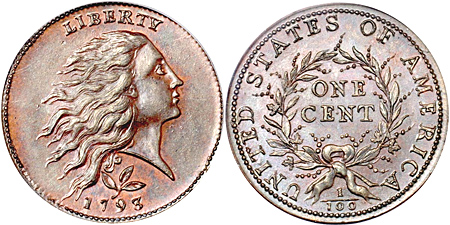Making Cents: The First Designs and Future of the Copper Cent
The first copper coin circulated by the U.S. Mint in 1793 was the Chain Cent. This historic design, intending to conjure images of freedom and unity, received such a negative outcry from the public that within the following year designers toiled to re-design it not just once, but twice.
 The wreath cent (right) was created after criticism of the original Liberty chain cent (left).
The wreath cent (right) was created after criticism of the original Liberty chain cent (left).Photograph submitted by Rebecca Troutman
The 1793 Chain Cent is not the only coin to have endured controversy in the U.S. Mint's history, but it was the first. The fledgling U.S. Mint hired coiner Henry Voigt to produce its first design. The men of this time period who worked with the dyes and design of the coins were craftsmen who had likely apprenticed as artisans or silver smiths. They were not known as "designers" as we imagine them today; the process of creating coins was extremely physical and demanding. Coiners manually heated metal sheets in a furnace and flattened them with repeated trips through rollers. They then harnessed horses to power the crude machinery through which coin shapes were fed by hand and pressed.
The Chain Cent was controversial for two reasons: Lady Liberty's wild appearance and the use of chains to signify the free republic's founding colonies. On the coin's face was the profile of Lady Liberty's with free-flowing, long hair. It was inspired by French medalist Augustin Dupre's Libertas Americana medal, which was struck by the Paris Mint in 1783 to celebrate the American Revolution. The long, tousled hair was meant to celebrate freedom, but to most citizens, Lady Liberty simply looked uncivilized. One writer of the Pennsylvania Gazette reported in March of 1793 that "Liberty…appears to be in a fright."
Mint Director David Rittenhouse went to work immediately on new sketches, working alongside designer and engraver Adam Eckfeldt, for the Wreath Cent-which was circulated less than four months after the Chain Cent. The new Liberty's longer hair was still blowing wildly, but her head looks slightly upward above the horizon in a stance of pride and confidence. The offensive chains on the reverse were replaced by a wreath of a plant with berries, resembling laurel.
Rittenhouse then hired Joseph Wright to design yet another version of the copper coin in the U.S. Mint's troubled first year. Known as the Liberty Cap cents, Wright finally tamed wild Liberty's flowing hair and added a liberty cap, an ancient symbol of freedom, to her image. Satisfied they had reached a design that suited the new republic, versions of this coin remained in production until 1857.
So what will the future of the one-cent coin bring? Historians, greeting the question like a medical doctor delivering a poor prognosis, don't give the penny much longer to live. From a purely economic standpoint, says Douglas A. Mudd, Money Museum Curator for the American Numismatic Association (ANA), the penny is, ironically, unaffordable for the Mint to maintain: "What puts the nail on the coffin for many treasuries [around the world] is the fact that the lowest denomination's metallic content is actually more valuable than the denomination itself." Over time, the U.S. Mint has changed the composition of the cent coin so that it's not too expensive to produce-currently a copper-coated zinc. "The problem is," says Mudd, "eventually the values of the metals will catch up to that."
Resources:
Also in this Issue:
- Copper Weather Vanes: Then and Now
- Copper Moon Woodworks: Shedding New Light on Windowshutters
- Making Cents: The First Designs and Future of the Copper Cent
- Andy Brinkley: Fusing Nature into Metal
- Cantor Expands Rodin Galleries
